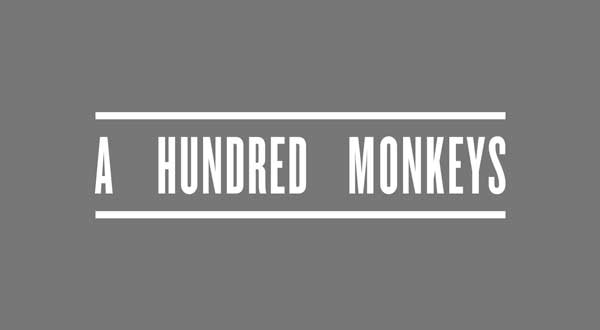The state of writing at A Hundred Monkeys
At the end of every year at A Hundred Monkeys our leadership team gets together in Mill Valley, down the street from the old auto repair shop where we first started working together. We reflect on the work we’ve done over the past year and talk about the work we want to do next year. At the end of 2107 one of our takeaways was that we wanted to do more writing work. While naming was still the focus, we recognized an opportunity to grow existing relationships by working on brand story, positioning, and key messaging. Most people call this stuff branding. We call it writing.

We were interested in this work for a few reasons:
• We’re all writers — it’s the main skill we hire for.
• Writing dovetails nicely with naming — it’s all words, now we’re allowed to use more of them.
• Writing work represented an opportunity to grow our business through a skillset we already had.
• Writing work posed a variety of new and interesting challenges.
In 2017, 7% of our projects involved writing. We basically fell into this work. It was all for existing clients with whom we had strong relationships.
In 2018, 15% of our projects involved writing. The main change we made was pitching writing work to existing clients where it made sense.
In 2019 so far, 38% of our projects have involved writing. We really didn’t change much this time. We worked on a few writing-only projects when we felt good about the relationship. Beyond that the work was all repeat clients and referrals. The jump caught us off guard. With two out of every five projects involving writing we’ve been forced to reckon with the scalability and sustainability of writing work. We know we don’t want to hire to meet the demand so the conversation has focused on how we can become more efficient and which projects are really worth taking.
Here’s what we’ve learned about writing projects so far:
Writing projects are more complicated than naming projects
All naming projects aim to end up at the same place, a good name. Because of this we developed a stepwise process that anyone on the team can execute. Conversely, writing projects end up all over the map. Clients are looking for a diverse range of outputs. We know we don’t want to write client blogs or do anything else that could be construed as “content,” but beyond that we aren’t particularly prescriptive about what we’re writing as long as we like the people we’re working with and there’s enough budget. While we’ll likely narrow the focus over time, it feels like we’d be doing our clients a disservice by putting everyone through a one-size-fits-all process.
Writing requires more alone time
Because of this variability, and also because of the nature of writing itself, these projects take more time. We often reference Paul Graham’s 2009 essay, “Maker’s Schedule, Manager’s Schedule.” Graham argues that there are two types of schedules: maker and manager. Makers need long uninterrupted blocks of time to get work done. Managers need shorter meeting blocks to meet with a bunch of people and check in on everything. Writing fits squarely within the maker’s schedule. You can’t spend 20 minutes writing between meetings or calls. Well, you can, your writing will just be garbage. Good writing requires bigger windows of uninterrupted thought. This is also supported by Cal Newport’s findings in Deep Work, which helped me write the core of Run Studio Run in three or four weeks of early morning writing. Conversely, naming is finite enough that you can make real progress in an hour or less. So when writing starts to take up more of our time, we needed to think about our schedules differently. Recently, when I was in the middle of a big writing project, I decided to basically split my day in half. I came into work around eight and worked on naming until lunch. After lunch I went home and worked on writing without checking email or Slack until dinner. It was mentally exhausting, but it worked. I’m hoping to evolve this schedule over time.

There’s too much pedagogy and jargon around writing work
Writing-based brand deliverables go by many names: manifestos, brand stories, narrative arcs, why statements, brand purpose, audience-specific messaging, mission statements, elevator pitches — the list goes on. These terms are more confusing than they are helpful. Some clients come to us asking for specific deliverables. When we ask why, good answers are hard to come by. This is likely because they’ve worked with branding professionals in the past who have talked about their process and deliverables like they’ve been outlined in the holy scriptures. I’m not mad about it. By all means, if that’s what you need to do to sell your work, I get it. I’ve sat across from branding people who say things like “every brand needs a purpose, vision, and mission,” or “we know that all good stories have three essential components.” To me, these are post-rationalizations based on whatever is being sold. Because branding often lacks the physicality of other work, practitioners build the myth to make clients feel like they’re getting their money’s worth.
Getting good feedback is difficult
We’ve just started to think about better ways to get feedback on writing work. With small teams, sharing a Google doc and opening it up to comments can work out fine. With bigger teams this turns into a hornet nest pretty fast. With naming we work early on in projects to limit the stakeholder team. We’re strong believers that more people equals more opinions. Most leaders want to make the final decision and it’s easy enough to explain to them that inviting more people into the process makes that final decision harder. However, most leaders also don’t have the time or patience to work through a bunch of writing. This often means you’re working with a marketing team who has their own objectives and is also trying to be a proxy for their leadership. This creates a game of telephone. To me, the simplest answer here is to just work on writing projects where the conditions are setup to get good feedback. We’re also looking at tools like Ulysses to help manage revisions and feedback.
We’re still learning here and that’s the interesting part. We’ve spent twenty years honing our naming process and it’s still evolving. Most of the changes we’re making these days are pretty small. Developing new processes around writing feels more like being on a frontier. We’re asking ourselves the big questions about the work we want to be doing and how to make it most effective. It feels good to start from the beginning again.



